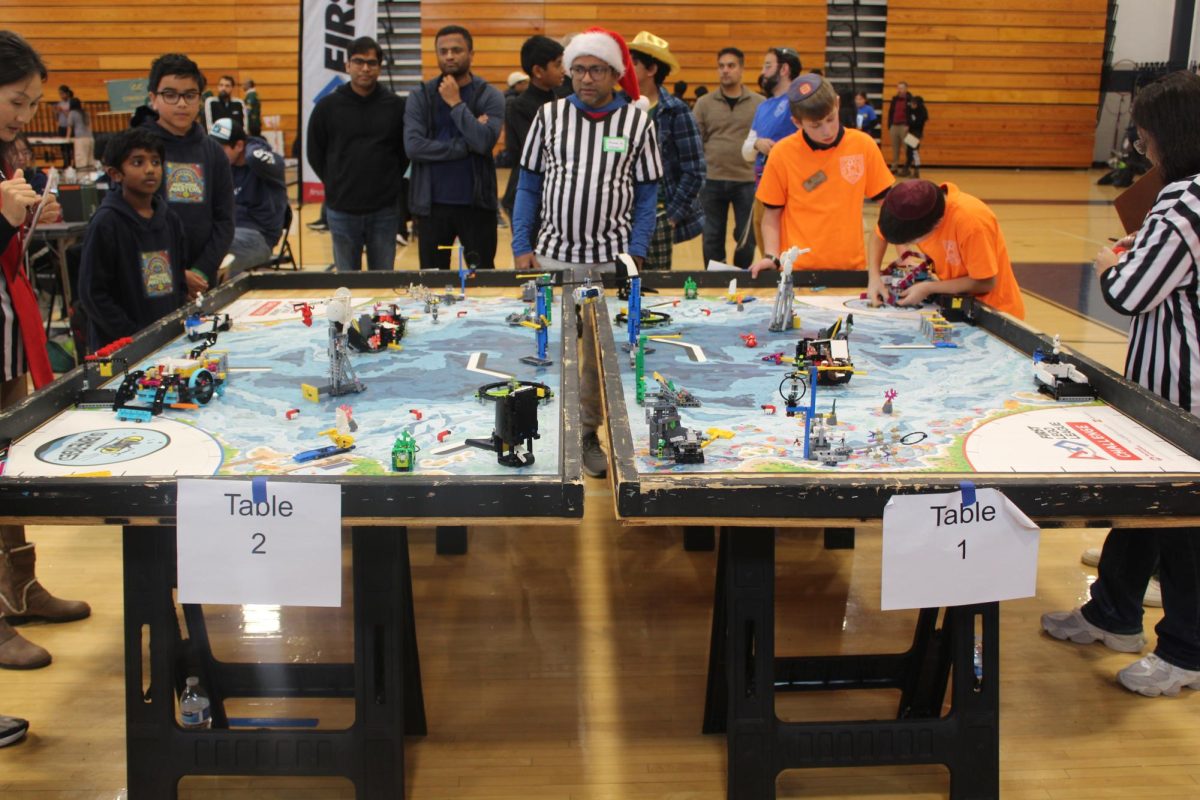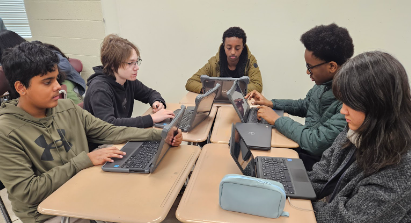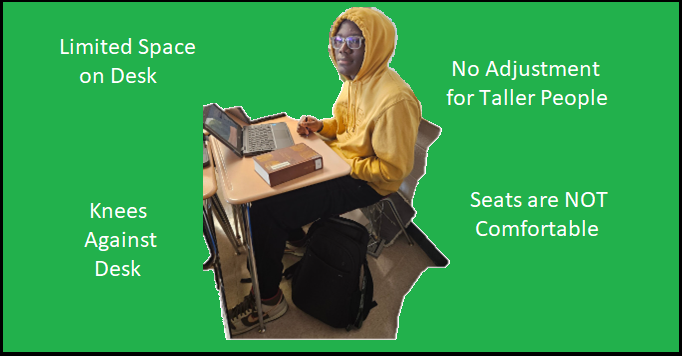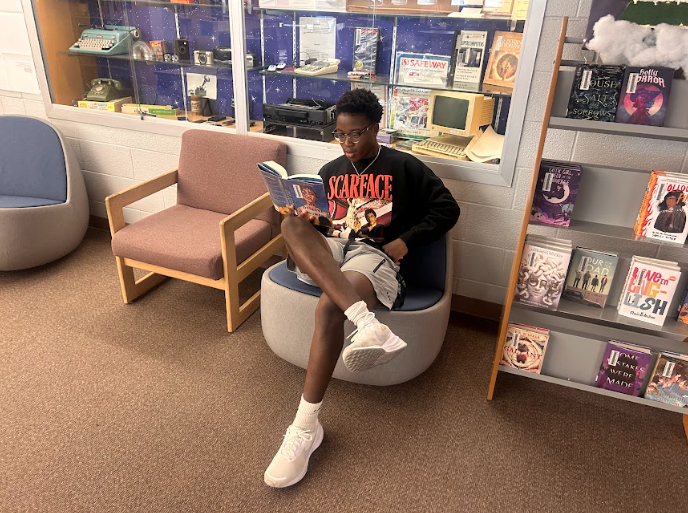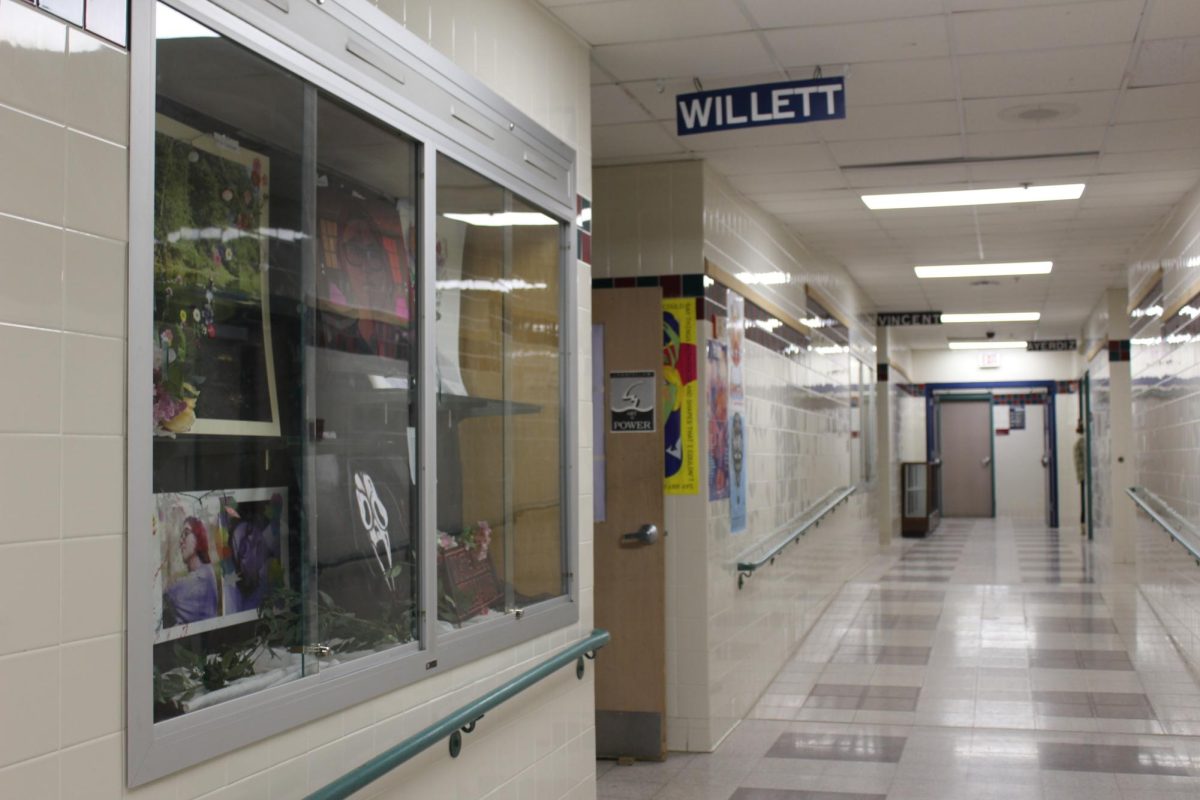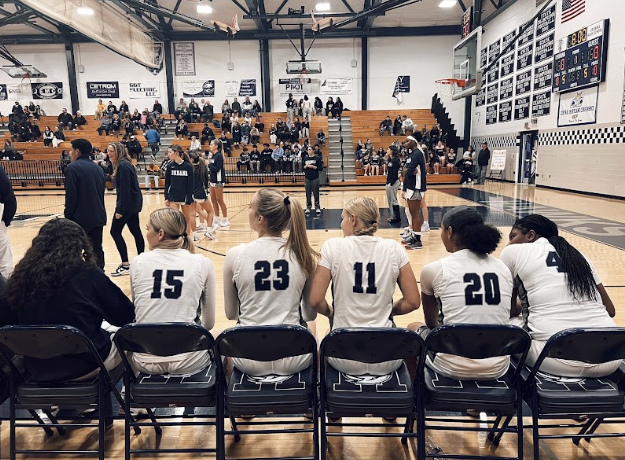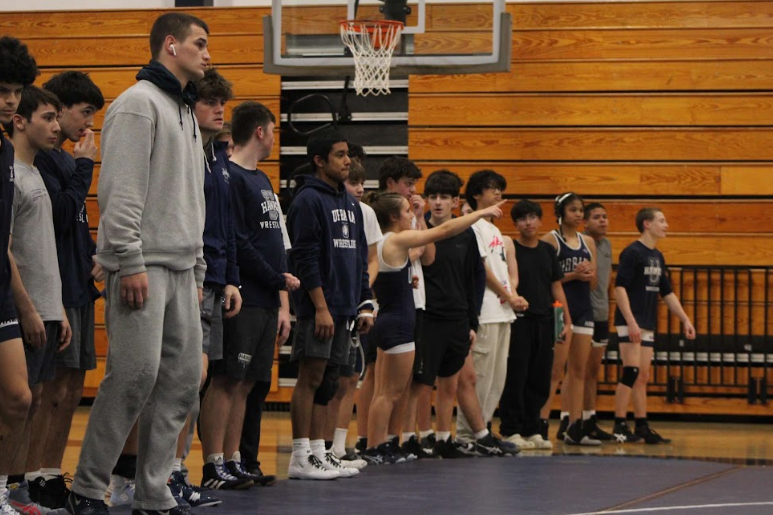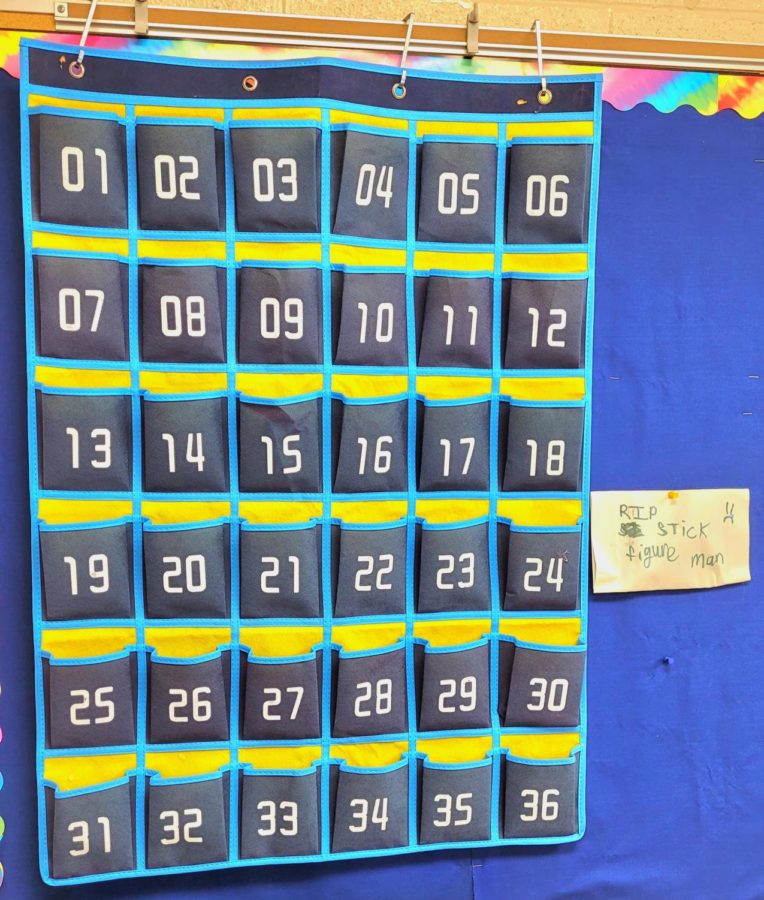Classroom Clash: Student-Teacher Disagreements on Cell Phone Use
Should phones be allowed in classrooms?
Mr. Brubaker’s Classroom Phone Caddy, Unused
February 6, 2023
The teacher stands at the head of the classroom, pointing towards the whiteboard and projecting her voice across the class. Meanwhile, a sea of students sits idle, chatting amongst themselves, their faces buried on their desk, or texting underneath the table. She holds no power in this room.
Teachers and students are at a divide. While teachers go to great lengths to control phone usage in their classrooms, students go to even greater lengths to keep their phones at their side. This holds true even here at Urbana. While teachers put up phone caddies with assigned numbers in order to keep track of the distraction, students deploy decoy phones in order to smuggle them back to their desk. Although there seems to be much conflict of opinion, students and teachers do occasionally agree.
In his classroom, business teacher Mr. Brubaker allows his students to keep their phone on them and only use them when he’s not giving instruction. He believes that having a caddy is “too much of a hassle” and not worth the effort, especially when he feels he can trust his students for the most part. When asked if he enforces his policy, he gave a quick yes, but doesn’t feel its always neccessary. Social studies teacher Mr. Friedland has a similar policy. “I expect y’all can handle your cell phone use appropriately. Typically, it’s to make sure you’re not using it during lectures” he said.
Mr. Friedland doesn’t enforce this, unlike Mr. Brubaker. “Since you guys are upperclassmen I trust you to know when it’s distracting. But if you start failing, there might be a problem” – Mr. Friedland trusts his students enough to navigate their own cell phone usage. These teachers, Mr. Brubaker and Mr. Friedland, seem to have a more relaxed approach to phone usage in their classrooms. This approach can lead to a more positive classroom environment, with a better understanding between students and teachers, as students are given more trust and autonomy.
Senior Jack Crosby sees eye-to-eye with Mr. Friedland’s policy. “I believe we should be trusted to use it when we want to. But, also, we should know as we grow older not to go on it while the teacher is giving instruction. It’s disrespectful”, he said. He then confessed “But I don’t want to be penalized just for having my phone on my desk. That’s scary”. In Mr. Friedland’s class, having your phone on your desk is no crime, but the same cannot be said about other classes.
When in Mrs. Levin’s class, for example, having a phone on you is not acceptable. Mrs. Levin has a caddy set up at the front of the class with set numbers in order to count who has their phone on them. She likes to joke she’s allergic to phones, but in reality she says “there’s no need for them”. She says “when people are on their phones they’re watching something, they’re checking their social media, they’re not paying attention. Many people don’t have self regulation”. Mrs. Levin does not perceive phones as a potential tool, but only as a distraction. According to recent studies, the average person checks their phone every 12 minutes and spends around 4 hours per day on their mobile device. Additionally, approximately 80% of cell phone users report feeling anxious when their phone is not in reach. That’s why she believes she is alleviating this distraction in her classroom. She wants all of her students to stay engaged with the material, and does not trust that cell phones will stay away.
Despite Mrs. Levin’s thoughts, others claim that cellphones can be a tool. Studies by MOJET have shown that students who use smartphones for educational purposes, such as research or taking notes, tend to have better academic performance than those who do not. Additionally, a survey conducted by Common Sense Media found that 66% of teenagers believe that using their smartphones in class helps them learn, while 64% of teachers agree that smartphones can be used as a learning tool. So, although phones are evidently tools, their distraction-factor is just as prominent.
As an English teacher, Mrs. Olsen does not typically allow phone usage as it’s a distraction to the reading. However, if a student needs to use it for looking something up when their computer doesn’t work, she will readily allow it. This is in contrast to Mrs. Levin’s environment, who would insist a student charges their chromebook or simply borrows a new one from the media center. Mrs. Olsen wants her students to be mindful in their usage and remain engaged in content. But, sometimes, phones are needed in order to achieve this.
Rules on cell phones differ based on views, and views differ based on personality. Senior Jack Crosby even mentioned it may be a generational issue; he has noticed the older teachers are less comfortable with phones because they were not raised around them. It is the younger teachers who are familiar and, therefore, trust their student’s cell phone usage. It may also depend on the age of students. Mr. Friedland remarked that his lenient cell-phone policy is in place because he puts greater trust in his upperclassmen students.
As a highschool senior who spends most of his time in college classes, Justyn Liversage is accustomed to the free-reign of his peers who tend to be much older. Like Jack, he believes “phone usage should be allowed during lectures and work time when the student would otherwise be allowed internet access”. He admits to often using his phone during his own classes, specifically during lectures where he’s already proficient with the material. This is in contrast to student Jack Crosby’s beliefs, who believes that using phones during lectures is a sign of disrespect. “If the student cannot properly understand and retain information during lectures due to phone use, that’s their fault. They will face the consequences of not being able to manage their time” said Justyn. His classes don’t require him to put away his phone and trust him with his responsibilities. In college, students are often treated as adults and given more freedom and autonomy in their learning. This is not always the case in high school where there may be more strict rules and regulations in place.
However, younger highschool students also believe they should be allowed freedom. Junior Corrine Capino says “I believe that students should be allowed to go on their phones whenever they want as long as you are able to work in a timely manner”. Although Corrine may not be as old as a senior, she still wants the trust that they seem to be granted. “It’s our phones. It’s our property. We have the freedom to do what we want with it. Not all students have a lot of freedom on their phones at home either, yet everyone deserves it”. Corrine’s viewpoint reflects the growing trend of technology integration in education, where students are increasingly using their personal devices for learning and academic purposes. This shift has led to a need for reevaluating traditional classroom policies and practices to better align with the ways in which technology is being used by students. The use of personal devices in the classroom can have many benefits, such as allowing students to access a wider range of educational resources and tools, facilitating collaboration, and providing opportunities for personalized learning.
Most would agree a solution is long overdue. To resolve the argument about cell phone usage during class between teachers and students a clear and comprehensive cell phone policy should be established. Involving students in the policy-making process can help to ensure their buy-in and compliance with the rules. It would be helpful to address the phone issue on a county-wide level. If FCPS makes a policy which addresses students needs for their phone, their would be less confusion class-to-class. However, if this policy is too strict, it may cause uprising. By finding a common ground and working together, teachers and students can create a positive and productive learning environment where technology can be used in a responsible and beneficial way.
The general student consensus is that phones should be allowed on you and put away, respectfully, during lectures. Electronics are going to continue to live in classrooms as long as their popularity prevails. However, respect from students towards teachers is crucial in earning that respect back. Be mindful of how you use your phone, you never know what you’re missing.
Mrs. Olsen said it best: “It’s like everything else. It’s the use that we put it to that counts”
Works Cited
Ng, Siew Foen, and Syamimi Iliani Che Hassan. “The Relationship between Smartphone Use and Academic Performance.” MOJET, MOJET, 2017, files.eric.ed.gov/fulltext/EJ1156718.pdf.
Swns, SWNS. “Americans Check Their Phones 80 Times a Day: Study.” New York Post, New York Post, 8 Nov. 2017, nypost.com/2017/11/08/americans-check-their-phones-80-times-a-day-study/.
Wakefield, Jane. “People Devote Third of Waking Time to Mobile Apps.” BBC News, BBC, 12 Jan. 2022, www.bbc.com/news/technology-59952557.










